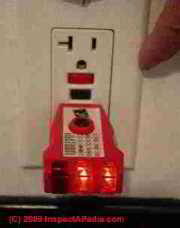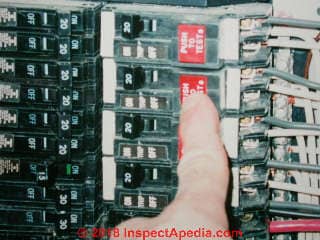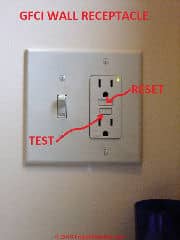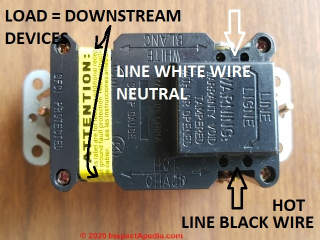 Ground Fault Circuit Interrupters, GFCIs
Ground Fault Circuit Interrupters, GFCIs
Definition & performance of GFCIs,
Electrical Code GFCI Requirements
- POST a QUESTION or COMMENT about ground fault circuit interrupters
Ground Fault Circuit Interrupters, GFCIs:
Definition of GFCI, what is a GFCI, and when should a GFCI trip or turn off an electrical circuit? What is the level of electrical shock protection provided by a GFCI or ground fault circuit interrupter.
What are the electrical code requirements for GFCIs? Where are GFCIs required to be installed?
This article series GFCIs and AFCIs as well as safe GFCI & AFCI installation, wiring, testing, and inspection.
InspectAPedia tolerates no conflicts of interest. We have no relationship with advertisers, products, or services discussed at this website.
- Daniel Friedman, Publisher/Editor/Author - See WHO ARE WE?
GFCI-Protected Electrical Receptacles

A GFCI or Ground-Fault Circuit Interrupter is a safety device intended to prevent electrical shock by detecting an improper flow of electrical current and shutting the electrical circuit off very quickly - in milliseconds.
The GFCI is designed to protect people from severe or fatal electric shocks by quickly detecting a small flow of electrical current between the electrical circuit (wires, switch, electrical receptacle or something plugged-in to the receptacle) and "ground" or the earth.
A GFCI also can protect against some electrical fires by detecting arcing and other faults to ground but a GFCI cannot detect hazardous across-the-line arcing faults that can cause fires.
[Click to enlarge any image]
A ground fault is an unintentional electric path diverting current to ground. Ground faults occur when current leaks from a circuit.
How the current leaks is very important. If a person’s body provides a path to ground for this leakage, the person could be injured, burned, severely shocked, or electrocuted.
If a person is touching a live electrical wire or is touching an electrical appliance inside of which a wire has come loose and is touching the appliance body while the person is also grounded (standing on a wet floor or touching a metal water pipe) that person could easily suffer a fatal electrical shock.
The U.S. National Electrical Code requires GFCI protection for receptacles located outdoors, in bathrooms, garages, kitchens, crawl spaces and unfinished basements;
and at certain locations such as near swimming pools where the risk of electrical shock is high because people are likely to be both near electrical circuits and device and in wet or damp or otherwise high-risk locations where they're also likely to be electrically grounded.
What is the "Trip Level" of GFCIs? - at what current should a GFCI device shut off the circuit?
Many sources describe the effects on a person of receiving an electrical shock at various levels of current, measured in amperes. Very low levels of electrical current, in the 50 mA to 4A range can cause heart fibrillation and at 4A or higher, heart paralysis, tissue or organ burning, i.e. death is very possible.
Half of people in the general population will "freeze" or be unable to let go of an electrical device at 10-15 mA of electrical current.
Note: 1 mA is one milliamp or 1 one-thousandths of an ampere of current flow. A typical household lighting circuit or receptacle circuit is wired for a total electrical load or current draw of 15 Amps.
Therefore GFCIs are typically designed to trip in the 4-6 mA range. Setting GFCIs to trip or to turn off the electrical circuit at current leakage or flow rates lower than that would raise a convenience issue as electrical circuits would experience high nuisance tripping. - (ANSI/UL Standard 943, Class A GFCI Trip Level) (NEMA 2012)
How Quickly Should a GFCI Trip Off?
The speed at which a GFCI device should shut down the circuit is not a fixed amount of time. Rather, the higher the current-flow, the faster the device should trip. At 6 mA of electrical current flow, a typical GFCI will trip off in just under six seconds. At that level a person might just feel the tingle of electrical current flowing through their body.
At a much higher, potentially fatal current level of around 264 mA, the GFCI device should trip off in just about 25 milliseconds. (25 thousandths of a second).
Related Electrical Safety Devices: AFCIs & Combination AFCI/GFCI devices
AFCIs, a different types of electrical circuit safety device, arc faults or electrical circuit arcing and the use of AFCIs are discussed separately at AFCIs ARC FAULT CIRCUIT INTERRUPTERS - devices intended to provide improved fire protection.
A combination AFCI and GFCI can be used to satisfy the NEC requirement for GFCI protection only if specifically marked as a combination device.
Where are GFCI's Required to be Installed?
 NFPA 70, the U.S. National Electrical Code (NEC) requires that Ground Fault Circuit Interrupters or GFCIs must be installed at high-risk locations where a person might touch an electrical device, circuit, or component and be close to water (piping, drains, wet floors, damp locations) or might be easily grounded:
NFPA 70, the U.S. National Electrical Code (NEC) requires that Ground Fault Circuit Interrupters or GFCIs must be installed at high-risk locations where a person might touch an electrical device, circuit, or component and be close to water (piping, drains, wet floors, damp locations) or might be easily grounded:
thus where people are at extra high-risk of being shocked or killed by an electrical fault that allows electrical current to pass through their body. GFCIs used in residential buildings where electrical circuits are limited to 240V or less are designated as Class A devices.
Below, using the U.S. 2008 NEC as an example we will list the locations where GFCI devices are required in residential properties.
The NEC also requires class A GFCI's to be installed on all 5-Amp and 20-Amp 120V utility receptacles ("electrical outlets") in high risk commercial locations such as in restrooms, kitchens, b asements, roofs, and outdoor receptacles.
The U.S. NEC has required GFCIs in various locations since 1971, or beginning in 1965 if we include underwater lighting, with the latest updates and changes to GFCI requirements in the 2014 NEC.
2014 NEC 210.8 GFCI Protection for Personnel, Dwelling Units
Excerpting from the NFPA,
GFCI protection is required by the 2014 NEC for newly installed and replacement 15 and 20 amp receptacles on kitchen countertops, in bathrooms, outdoor areas, unfinished basements and crawl spaces, garages, boathouses, laundry areas, and within 6’ of sinks, bathtubs and shower stalls.
GFCI protection is also required for certain appliances that have a history of being a shock hazard. Drinking fountains, vending machines, dishwashers and boat hoists are examples of appliances that require GFCI protection.
In 2014 additional details on GFCI protection were added to prior code specifications such as the following: [Note that this is an example, not a complete citation of the entire 2014 NEC code on GFCIs]
Any 125 V, single-phase, 15- or 20- amp receptacle within 6 ft. of the outside edge of a sink in a dwelling unit must now have ground-fault circuit-interrupter (GFCI) protection. This requirement is now for kitchens as well as other areas of the dwelling unit.
This includes receptacles for a garbage disposal, refrigerator, or range hood, if they are within 6 ft. of the sink. The distance does not have to be horizontal, so a receptacle on a kitchen island would require GFCI protection if the shortest route to the sink was less than 6 ft.
2008 National Electrical Code (U.S. NEC) Changes Affecting Ground Fault Circuit Interrupters GFCI's
 NEC 210.8 is the code section pertaining to GFCI's. (AFCI's are addressed in NEC 210.12.). These GFCI requirements are intended to address residential electrical wiring using 15A or 20A 120V electrical receptacles and circuits. Heavier-duty circuits such as a 30A welder circuit are excluded.
NEC 210.8 is the code section pertaining to GFCI's. (AFCI's are addressed in NEC 210.12.). These GFCI requirements are intended to address residential electrical wiring using 15A or 20A 120V electrical receptacles and circuits. Heavier-duty circuits such as a 30A welder circuit are excluded.
Basically GFCI protection requirements have been expanded to all basement, garage, and accessory building receptacles, and a wording change to drop "receptacles" and keep "outlets" expands GFCI coverage in other areas.
For 2008 the NEC deleted Nos. 1 and 2 to 210.8(A)(2) and Nos. 1 and 2 to 210.8(A)(5) from the prior NEC version.
210.8(A)(2) & (A)(5): Expanded GFCI protection requirements by deleting exceptions for receptacles that are not readily accessible and receptacles located in dedicated spaces to supply an appliance.
Deleting "receptacle" and leaving "outlet" in the NEC expands the required coverage of any device being discussed. That's because a "receptacle" is taken to mean an electrical outlet (a wall socket) while "outlet" is any place in the electrical wiring system from which electrical power is taken (a ceiling fan, a hard-wired smoke detector, etc.).
• 210.8(B)(4): Expanded GFCI protection requirements to include all outdoor 15- and 20-ampere, 125-volt receptacles, and added a conditional exception to permit use of assured equipment grounding conductor program in industrial establishments.
• 210.8(B)(5): Added GFCI protection requirements for all 15- and 20-ampere 125-volt receptacles installed within 6 ft of the outside edge of sinks, and added exceptions for receptacles in industrial laboratories where the loss of power would introduce a greater hazard and for receptacles in patient care areas where critical care equipment may be utilized.
Basement GFCI changes: The GFCI protection requirements for receptacles in basements, garages, and accessory buildings have been expanded to all 125-volt, single-phase, 15- and 20-ampere receptacles regardless of accessibility or movability of an appliance from one location to another. - Minnesota Electrical Association
A Summary of Current (2008) Residential Ground Fault Circuit Interrupter GFCI Requirements
GFCI's are required safety devices to be installed in the following locations:
- Bathrooms:
are required to provide one 15A or 20A, 125V receptacle (or more). All bath receptacles have to have GFCI-protection, and at east one must be within 3 feet of the outside edge of each basin [210.52(D)].
The bathroom receptacle circuit cannot provide power to other outlets elsewhere in the house [210.11(C)(3)] - something that is commonly found in older homes.
There is an exception for a 20A circuit that supplies only a single bathroom: other equipment within the same bathroom, such as lights or a bath vent fan can be powered from the circuit. (A home inspector who detects this might point out the inconvenience of being left in the dark if the GFCI trips.)
Whether inspecting a new home, to which the 2008 NEC applies, or inspecting an older home that was wired before this code was written, the tracing of wiring to determine what devices are powered by each electrical circuit is not within the scope of practice of a normal home inspection meeting national or state standards. - But some circumstances will require this level of scrutiny on existing structures.
- Boathouses: do not require that electrical receptacles be installed at all, but if a receptacle is present it must be GFCI protected.
- Crawl spaces (at or below grade): receptacles are not required to be installed in these areas unless HVAC equipment is installed in the crawl area, but if an optional electrical receptacle is installed in the crawl space, it must be GFCI protected. We pose that such receptacles may be in place for temporary work lighting or for powering sump pumps. (GFCI trips, no sump pump, flood).
- Garages: must provide a GFCI protected electrical outlet, regardless of whether or not the garage is attached or detached.
There are exceptions in the garage for electrical outlets which are not readily accessible, such as a ceiling receptacle used to power a garage door opener, and an exception for dedicated circuits such as one to provide power to a refrigerator or freezer.
(In freezing climates these appliances may not work properly in an un-heated space even if it's legal to hook them up there.) NEC 100 defines "readily accessible." - Kitchens: GFCI protected receptacles are required for all receptacles that serve counter surfaces. (We like this rule because in the past builders would skip the GFCI protection for a receptacle that was over a kitchen counter but was just one inch more than six feet from the sink.)
Exceptions to GFCI requirements for kitchens include circuits for built-in appliances like garbage grinders and dishwashers. - Laundry (and also wet-bars): require that GFCI protection be provided for any receptacles within six feet of the laundry sink (or wet bar sink).
So a receptacle used to power a washing machine or a gas-fired clothes dryer needs to be GFCI protected if it's within six feet of a sink. - Outside electrical outlets that are GFCI protected are required, at least one for a single family dwelling. 210.52(E).
All outside electrical receptacles must be GFCI protected, even those receptacles found under the roof eaves and typically used for holiday lighting or for an ice-dam stop-gap measure heat tape.
(Better solutions for ice dam problems than a heating tape are discussed
at ICE DAM LEAKS.)
An exception outside is for a dedicated ice-dam snow-melting heating tape on a dedicated circuit that is not readily accessible and complies with 426.28 for ground-fault protection of equipment. - Unfinished basement areas: a single GFCI protected electrical receptacle is required in each room or area of an un-finished basement. 210.52(G), and all receptacles that are installed (thus including optional additional receptacles) must be GFCI protected.
Exceptions to the GFCI protected receptacle requirement for un-finished basements include the usual cases: receptacles that are not readily accessible and receptacles on dedicated circuits, such as a freezer appliance circuit.
Summary with Dates Showing Where is GFCI Protection Required
NEC GFCI requirements (and effective date):
Underwater pool lighting (since 1968)
Receptacles:
- Outdoors (since 1973)
- Bathrooms (since 1975)
- Garages (since 1978)
- Kitchens (since 1987)
- Crawl spaces and unfinished basements (since 1990)
- Wet bar sinks (since 1993)
- Laundry and utility sinks (since 2005)
GFCI Installation Options & Wiring Details
This discussion has moved to GFCI DEVICE SELECTION & WIRING
GFC Testing Instructions
This discussion moved to its very own page at GFCI TEST PROCEDURES.
Also see AFCI GFCI WIRING, TESTING & SAFETY
GFCI Manufacturers, Guides, Standards
- Eaton, INSTALLING & TESTING a GFCI RECEPTCLE [PDF], Eaton, Website: www.eaton.com or www.cooperwiringdevices.com retrieved 2018/07.27,original source: http://www.cooperindustries.com/content/dam/public/wiringdevices/products/documents/instruction_sheets/EIS-0018-E.pdf
- Hubbell, INSTALLING & TESTING a GFCI RECEPTACLE [PDF] , Hubbel Corporation, 40 Waterview Dr., Shelton CT 06484 USA, Website: retrieved 2018/07/27, original source: http://www.arrl.org/files/file/Technology/GroundingAndBonding/Installing%20and%20Testing%20a%20GFCI%20Receptacle.pdf
- Larson Electronics, Tel: 1-877-432-0861 / International: 1-903-498-3363 Email: sales@larsonelectronics.com, Website: larsonelectronics.com Larson provides GFCI protected linecords and other electrical equipment.
- Legrand, INSTALLING and TESTING a GFCI RECEPTACLE [PDF] Pass & Semour Legrand, PO Box 4822, Syracuse NY 13221 USA, Tel: 800-223-4185, Website: www.legrand.us, retrieved 2018/07/27, original source:
Excerpt:
This is a Self-Test GFCI Receptacle with SafeLock Protection™; it conducts an automatic test every three seconds, ensuring it’s always ready to protect. If the device fails the test, the indicator light flashes to signal that the GFCI should be replaced. It also has our proven SafeLock Protection feature: if critical components are damaged and protection is lost, power to this receptacle, and any downstream receptacles, will be disconnected. - Leviton, GFCI INSTALLATION & TEST PROCEDURES [PDF], retrieved 2018/07/27, original source: https://www.leviton.com/en/docs/guidelight.pdf
- Siemens GFCI CIRCUIT BREAKER DATA SHEET & WIRING DIAGRAMS [PDF] retrieved 2018/09/07, original source: siemens.com/gfci
- Siemens CIRCUIT BREAKER & GROUND FAULT CIRCUIT INTERRUPTER Specifications Sheet [PDF] retrieved 2018/09/07, original source: https://gfiwarehouse.com/~gfiwareh/siemensdatasheet.pdf
- GFCI WORKPLACE TEST REQUIREMENTS OSHA U.S. OSHA, - retrieved 2018/07.27, original source: www.osha.gov/laws-regs/standardinterpretations/1992-02-10
- U.S. CPSC, What is a GFCI, [PDF] U.S. Consumer Product Safety Commission, retrieved 2018/07.27, original source: https://www.cpsc.gov/s3fs-public/099_0.pdf
...
Continue reading at GFCI DEVICE SELECTION & WIRING or select a topic from the closely-related articles below, or see the complete ARTICLE INDEX.
Or see these
Recommended Articles
- AFCIs ARC FAULT CIRCUIT INTERRUPTERS
- ELECTRICAL RECEPTACLE TYPES
- GFCI PROTECTION, GFCI CODES
- GROUND SYSTEM INSPECTION
- LOST NEUTRAL SHOCKS HOMEOWNER
- MULTI-WIRE CIRCUITS - don't install AFCI or GFCI on shared neutral circuits
- SAFETY for ELECTRICAL INSPECTORS - home
Suggested citation for this web page
GFCI PROTECTION, GFCI CODES at InspectApedia.com - online encyclopedia of building & environmental inspection, testing, diagnosis, repair, & problem prevention advice.
Or see this
INDEX to RELATED ARTICLES: ARTICLE INDEX to ELECTRICAL INSPECTION & TESTING
Or use the SEARCH BOX found below to Ask a Question or Search InspectApedia
Ask a Question or Search InspectApedia
Try the search box just below, or if you prefer, post a question or comment in the Comments box below and we will respond promptly.
Search the InspectApedia website
Note: appearance of your Comment below may be delayed: if your comment contains an image, photograph, web link, or text that looks to the software as if it might be a web link, your posting will appear after it has been approved by a moderator. Apologies for the delay.
Only one image can be added per comment but you can post as many comments, and therefore images, as you like.
You will not receive a notification when a response to your question has been posted.
Please bookmark this page to make it easy for you to check back for our response.
IF above you see "Comment Form is loading comments..." then COMMENT BOX - countable.ca / bawkbox.com IS NOT WORKING.
In any case you are welcome to send an email directly to us at InspectApedia.com at editor@inspectApedia.com
We'll reply to you directly. Please help us help you by noting, in your email, the URL of the InspectApedia page where you wanted to comment.
Citations & References
In addition to any citations in the article above, a full list is available on request.
- UL 943, Ground-Fault Circuit Interrupters, retrieved 2016/08/08, original source: http://ulstandards.ul.com/standard/?id=943
Excerpt:
1.1 This Standard applies to Class A, single- and three-phase, ground-fault circuit-interrupters intended for protection of personnel, for use only in grounded neutral systems in accordance with the National Electrical Code (NEC), ANSI/NFPA 70, the Canadian Electrical Code, C22.1 (CEC), and Electrical Installations (Use), NOM-001-SEDE. These devices are intended for use on alternating current (AC) circuits of 120 V, 208Y/120 V, 120/240 V, 127 V, or 220Y/127 V, 60 Hz circuits. Note: In Canada, the text "intended for protection of personnel" is excluded. - NEMA, "Understanding GFCIs, Developed by the NEMA 5PP Personnel Protection Technical Committee" [Power Point Presentation], (2012)retrieved 2016/08/08, original source: https://www.nema.org/Products/Documents/NEMA-GFCI-2012-Field-Representative-Presentation.pdf
- Antman, Steve, Roger Nolter, and Danny Liggett. "New rules for ground fault circuit interrupters." In 2011 IEEE IAS Electrical Safety Workshop, pp. 1-4. IEEE, 2011.
- El-Sherif, Nehad, Rick Mendler, John Trotte, and Ajay Pathak. "Ground fault protection of personnel in industrial locations using the new UL 943C." In 2014 IEEE Petroleum and Chemical Industry Technical Conference (PCIC), pp. 409-414. IEEE, 2014, retrieved 2016/08/08, original source: http://www.csemag.com/single-article/ul-s-new-gfci-classes/89c8746cdc4a7fd8a3cb93f1d51ba57a.html
- LaRocca, Robert L. "Personnel Protection devices for use on appliances." IEEE transactions on industry applications 28, no. 1 (1992): 233-238.
- Neitzel, Dennis K., and Timothy L. Gauthier. "Ground fault protection-GFCI or GFPE-there is a difference." In Electrical Safety Workshop (ESW), 2013 IEEE IAS, pp. 207-210. IEEE, 2013.
- Smoot, Arnold W. "GFCI---Applications and Alternatives." IEEE Transactions on Industry Applications 1 (1975): 56-61.
- Wills, John H., Jan Ehrenwerth, and Dan Rogers. "Electrical injury to a nurse due to conductive fluid in an operating room designated as a dry location." Anesthesia & Analgesia 110, no. 6 (2010): 1647-1649.
- Electrical shock injury statistics: www.healthatoz.com - September 2008;
High-tension current generally causes the most serious injuries, although fatal electrocutions may occur with household current (e.g., 110 V in the United States and Canada and 220 V in Europe, Australia, and Asia). Contact with alternating current at 60 cycles per second (the frequency used in most US household and commercial sources of electricity) may cause tetanic skeletal muscle contractions, preventing self-release from the source of the electricity and thereby leading to prolonged exposure. The repetitive frequency of alternating current also increases the likelihood of current flow through the heart during the relative refractory period (the "vulnerable period") of the cardiac cycle. This exposure can precipitate ventricular fibrillation (VF), which is analogous to the R-on-T phenomenon.-- circ.ahajournals.org - September 2008
- Mark Cramer Inspection Services Mark Cramer, Tampa Florida, Mr. Cramer is a past president of ASHI, the American Society of Home Inspectors and is a Florida home inspector and home inspection educator. Mr. Cramer serves on the ASHI Home Inspection Standards. Contact Mark Cramer at: 727-595-4211 mark@BestTampaInspector.com
- John Cranor [Website: /www.house-whisperer.com ] is an ASHI member and a home inspector (The House Whisperer) is located in Glen Allen, VA 23060. He is also a contributor to InspectApedia.com in several technical areas such as plumbing and appliances (dryer vents). Contact Mr. Cranor at 804-873-8534 or by Email: johncranor@verizon.net
- "Frequency of Occurrence and Sources of Rust and Corrosion in Electrical Panels," Daniel Friedman, IEEE HOLM Conference, Philadelphia PA, 1992 - see ELECTRIC PANEL RUST for an online version of this article.
- Jim Simmons: Personal communication, J. Simmons to Daniel Friedman, 9/19/2008. Photographs contributed to this website by Jim P. Simmons, Licensed Electrician, 360-705-4225 Mr. Electric, Licensed Master Electrician, Olympia, Washington Contact Jim P. Simmons, Licensed Master Electrician, Mr. Electric, 1320 Dayton Street SE
Olympia, WA 98501, Ph 360-705-4225, Fx 360-705-0130 mrelectricwa@gmail.com - Kenneth Kruger: Original author of the sidebar on testing VOM DMM condition: Kenneth Kruger, R.A., P.E. AIA ASCE, is an ASHI Member and ASHI Director in Cambridge, MA. He provided basis for this article penned by DJ Friedman.
- "How to Use DMM's Safely," Leonard Ogden, CEE News, 888 Seventh Ave., New York, NY 10106, Dec 1990 p.10.
- Dr. Jess Aronstein, consulting engineer, Poughkeepsie NY, 1991 protune@aol.com
- Rex Cauldwell, master electrician and contributor to the Journal of Light ConstructionOn electrical topics
- New York State Central Hudson Gas and Electric Company, G&E/1-2/85 consumer safety pamphlet
- American Society of Home Inspectors, ASHI Training Manual, Al Alk -[obsolete, and includes unsafe practices-DF]
- "Electrical System Inspection Basics," Richard C. Wolcott, ASHI 8th Annual Education Conference, Boston 1985.
- "Simplified Electrical Wiring," Sears, Roebuck and Co., 15705 (F5428) Rev. 4-77 1977 [Lots of sketches of older-type service panels.]
- "How to plan and install electric wiring for homes, farms, garages, shops," Montgomery Ward Co., 83-850.
- "Simplified Electrical Wiring," Sears, Roebuck and Co., 15705 (F5428) Rev. 4-77 1977 [Lots of sketches of older-type service panels.]
- "Home Wiring Inspection," Roswell W. Ard, Rodale's New Shelter, July/August, 1985 p. 35-40.
- "Evaluating Wiring in Older Minnesota Homes," Agricultural Extension Service, University of Minnesota, St. Paul, Minnesota 55108.
- "Electrical Systems," A Training Manual for Home Inspectors, Alfred L. Alk, American Society of Home Inspectors (ASHI), 1987, available from ASHI. [DF NOTE: I do NOT recommend this obsolete publication, though it was cited in the original Journal article as it contains unsafe inaccuracies]
- "Basic Housing Inspection," US DHEW, S352.75 U48, p.144, out of print, but is available in most state libraries.
- In addition to citations & references found in this article, see the research citations given at the end of the related articles found at our suggested
CONTINUE READING or RECOMMENDED ARTICLES.
- Carson, Dunlop & Associates Ltd., 120 Carlton Street Suite 407, Toronto ON M5A 4K2. Tel: (416) 964-9415 1-800-268-7070 Email: info@carsondunlop.com. Alan Carson is a past president of ASHI, the American Society of Home Inspectors.
Thanks to Alan Carson and Bob Dunlop, for permission for InspectAPedia to use text excerpts from The HOME REFERENCE BOOK - the Encyclopedia of Homes and to use illustrations from The ILLUSTRATED HOME .
Carson Dunlop Associates provides extensive home inspection education and report writing material. In gratitude we provide links to tsome Carson Dunlop Associates products and services.

